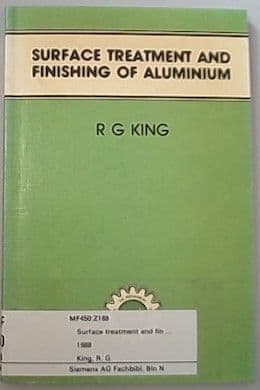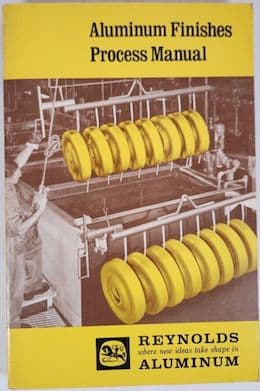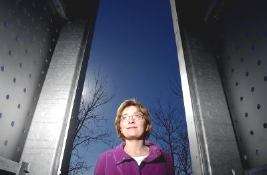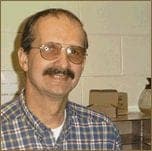
-----
Interference coloring of aluminum by pulse anodizing
Please see also:
• Topic 1611 "Hardcoating using Pulse Rectifier"
• Topic 14519 "Pulse Anodizing"
Q. I own 2 anodizing plants which I use to anodize aluminium for my curtain wall business.
I have heard that special pulsed power supplies are now available that will reduce the energy consumption of the plain anodizing process.
I have also heard that a variety of chemicals are available that enable one to anodize a variety of colors (in addition to the common colors of champagne, black and brown).
I will appreciate any pointers in this regard.
Thank you,
- Bombay, India
1996
for Shops, Specifiers & Engineers

avail from eBay, AbeBooks, or Amazon

avail from eBay, AbeBooks, or Amazon

avail from eBay, AbeBooks, or Amazon

avail from eBay, AbeBooks, or Amazon

avail from eBay or Amazon
(as an Amazon Associate & eBay Partner, we earn from qualifying purchases)
A. That is true .
Yes, companies are selling a piece of equipment which enables you to obtain a lot of different colors by anodising . I do not know if they save power though.
We have been using this technology with success for more than a year now.
-France
A. One company sells such a process, but as far as I know it only produces blue-gray finishes, and the cost of investment goes around US $100,000. It is a two step process, first you sulfuric acid anodize and then you color treat the part using a very hi-tech computer controlled rectifier. In the second step two processes occur, pore enlargement and metal deposition.
Another process which is described in US patents numbers (you can read a resume of them in www.uspto.gov) 4,152,222 and 4,066,816 involves a three step process, sulfuric acid anodize - phosphoric acid anodize to enlarge pores and color treatment (Sn or Ni usually), this process uses an alternating current power supply and you can get at least eight colors to my knowledge.
This process is also described in what happens to be the bible of anodizers, The Surface Treatment & Finishing of Aluminum and its Alloys by S. Wernick, R. Pinner, P.G. Sheasby, fifth edition, vol I, pages 641-649. Here both processes are described in a more general manner, but valuable information can be obtained.
Saludos desde MEXICO,
- Mexico City, Mexico
A. During the last 15 years I have been working with pulse anodizing. I am not selling any rectifier but have been so lucky as consultant to be involved in various projects about pulse anodizing.
These projects have shown that you will reduce the energy consumption when you use square wave formed pulse anodizing. This is purely a DC process where you ask your rectifier to change value during the process. This means that you can use your old rectifier.
Regarding coloring, interference coloring gives you a whole spectra of colors including the common ones.
Sunny regards

Anne Deacon Juhl
- - Trustrup Denmark
Multiple threads merged: please forgive chronology errors and repetition 🙂
Q. We are looking for papers, articles, etc., on:
- Hard anodizing of high copper alloys
- Using pulse rectifiers in Hard Anodizing
Any help appreciated.
David A. Kraft- Long Island City, New York
1998
A. Hi David, I know you guys do a lot of hard anodizing. There was a SAMPE symposium, I think it was in 1992 that was on Hard Anodizing and a couple of papers of interest to you, among others, were by J.S.Abbot of Nimet Industries, Inc. They talk to the effects of ramp rates of hard anodizing and also there were a couple of papers totally directed at hard anodizing of copper containing alloys, one specifically about burning.
I have looked for hard anodize papers using pulse type rectifiers without much success. Have you tried Charlie Grubbs? He would know what was out there.
aerospace - Wichita, Kansas
A. Hi. Anne Deacon Juhl of Aluconsult did her PhD thesis on pulse anodizing, and I believe it is possible to purchase a copy.
Regards,

Ted Mooney, P.E.
Striving to live Aloha
finishing.com - Pine Beach, New Jersey
Ted is available for instant help
or longer-term assistance.
July 31, 2009
A. Hi
As Ted tells you I have a book which can be purchased and also a lot of papers, articles, etc on both subjects.
- Hard anodizing of high copper alloys
- Using pulse rectifiers in Hard Anodizing
Sunny regards

Anne Deacon Juhl
- - Trustrup Denmark
Multiple threads merged: please forgive chronology errors and repetition 🙂
Benefits of Pulse Anodizing
Q. 1) I would like to know about the advantages and disadvantages of using pulse rectification in an anodizing process? Is this a trend in the US?
2) How does the proprietary hardcoat additives further help this process?
3) Anybody offers good pulse rectifiers?
Thanks for the attention.
- Hong Kong, China
1998
A. The pulse rectifiers allow you to run at a higher amperage because the pause between the pulses allow the piece to cool so that it doesn't burn. The density of the coating is increased. The coating is harder. Anodizing to the desired thickness is faster.
The disadvantage is that you have to purchase a new rectifier to get the advantages. As far as the US trend and additives I don't know. You may want to contact Dynapower in Vermont for a high quality pulse rectifier.
Regards
- Longwood, Florida
A. Both Dynapower and Rapid offer pulse units, and both have presented papers at various AESF shows. There is an excellent paper in the May 92 issue of Metal Finishing on pulse rectification. Pulse rectification has been around for a good 20 years or more, but hasn't taken over because we are a mature industry, and there is a reluctance to discard a perfectly good DC rectifier. There is also the element of exploring the unknown. This may initially be a disadvantage, as there is an educational process in learning how to use the technology to its maximum efficiency, and at the same time maintain production. Any hardcoater knows it is not too difficult to ruin parts in a hardcoat tank, and one needs to make sure one knows what is going to happen when the rectifier is turned on.
I agree with Mr. Jones that the key to higher efficiency is that the part is receiving pulses of very high amperage without the problems of increased part temperature. Not only does this prevent burning, but this results in a denser coating and less Al dissolution from the coating. I believe that at the same time the barrier layer retains a higher conductivity than a straight DC rectifier would provide with very high current densities, contributing to faster film build and ability to grow thicker coatings if desired. There are several other advantages as a result of this concept, including the choice of anodizing for shorter cycle times or, putting more parts on a rack. In some cases we used to hardcoat more parts at lower current densities and still got 2 mils in about 40 minutes.
Two other advantages: we did away with work bar agitation, and for many parts we were able to use titanium finger racks (caution: make sure the splines can carry the required current, and use the old rule of 8 amps per contact point). The higher voltages did make the titanium racks brittle over time, reducing titanium rack life, but we saved a great deal of racking time.
Hardcoat additives work by dissipating heat faster than a straight sulfuric acid solution, reducing the rate of aluminum dissolution from the film, again resulting in denser coatings and faster film build. The advantages are similar to what pulse rectification offers, but as you can probably tell, I liked the pulse rectifier. (I hope my boss doesn't read this; we sell additives but not rectifiers.)

Phil Johnson
- Madison Heights, Michigan
Multiple threads merged: please forgive chronology errors and repetition 🙂
Low Frequency Pulsed Anodizing on the Cheap?
Q. I've been researching low frequency (0.05 - 0.005 Hz) pulsed anodizing on behalf of a prospective client, and I'm wondering; is it necessary to purchase a dedicated rectifier to do this?
Based on my (admittedly limited) knowledge of electronics, it seems to me that this low frequency of electrical current could be delivered via a high current relay. I even have some ideas on how a circuit might be constructed to modulate the output of a conventional rectifier via cascaded transistors and/or relays. I don't imagine I'm the first person to think of this.
I have three questions:
1) Is there some kind of off the shelf "add on box" that one could attach to a conventional rectifier to do LFPA without buying expensive new equipment?
2) Is there a concern on a practical electrical basis with turning the current on and off at that frequency insofar as damaging the rectifier?
3) Is anyone else out there doing Low Frequency Pulsed Anodizing; and, if so, what has your experience been? It looks like a winner based on what I've read, but lots of things like that wind up being losers in production situations.
Thanks in advance for any useful advice.

Dave Wichern
Consultant - The Bronx, New York
January 13, 2009
A. Dave
Recently Dynatronix has been offering low frequency pulse as an option to its switch mode power supplies for applications such as yours.

Pat Mentone
St Paul, Minnesota
A. What type of rectifier are you using? A thyristor based rectifier would be cheap and easy to switch on and off and it would not at all harm the rectifier. A high current switch is limited in practicality by the amount of current, 100A no problem, 1000A look out. Haven't done it myself in production, but like you said it worked great in the lab.
Leo Herringon- Grand Rapids, Michigan, USA
A. Dave
If you can live with mains frequency, there is no cheaper alternative than a single phase half wave rectifier. It's cheap and simple to try. Or, you can double the frequency with a full wave rectifier provided it has no smoothing. 3 phase rectifiers will not do this due to the overlapping waveforms.
Don't get too hooked up on perfect square wave forms. I once hooked pulse rectifier up to an oscilloscope. Perfect square waves. Then I attached it to a plating tank. The capacitance of the plating cell took away both leading and trailing edges of the incredibly expensive square waveform and left … a near perfect positive half of a sine wave.
I decided that there were enough variables to worry about without paying for more. Wondrous things are claimed for pulse plating in the lab but I cannot remember when I saw one making money in a plating shop.
But your application may be different. Let us know how you get on.

Geoff Smith
Hampshire, England
Q. My original aim has changed - the inquiry was initially intended to serve the needs of a prospective employer. But, they showed a fundamental lack of judgement in refusing to hire me. :)
May I ask, Geoff: what type of plating bath was this? My new application is as a power supply to an electrolytic waste treatment unit. Our thinking is paralleled in that I was also thinking of using a simple half wave rectifier. However, I was also going to control the current by varying the duty cycle (the 'on' time vs. the 'off' time) and the easiest way to do this seemed to be a circuit regulated by a 555 timer.

Dave Wichern
Consultant - The Bronx, New York
February 7, 2009
A. Hi all
Pulse anodizing and pulse plating use the waves for two different purposes.
In pulse anodizing you want to let you oxide layer relax, so you can process with higher current density. Here I am talking about slow square-formed pulses from 10 - 300 seconds.
Pulse plating uses the pulses to build up a more uniform thickness, some metals plate with less cracks and with others a higher concentration of the chemicals are left in the layer.
I have done a lot of work about Pulse Anodizing and shown that you can increase your productivity with 50 % and decrease the energy consumption with up to 30%. This is when used for conventional sulfuric anodizing.
When using pulse anodising for Hard Anodizing the increase in current density will build a sounder and more compact layer.

Anne Deacon Juhl
- - Trustrup Denmark
A. Dave
As I recall, it was either an cobalt hardened gold or a High throw copper sulphate
⇦ on
eBay or
Amazon [affil link] (PC) I have never tried it on anodise.
The 555 makes a very simple and cheap timer for pulse circuits but you will probably have to use it to drive a Triac or similar to provide any useful current.

Geoff Smith
Hampshire, England
![]() First, to Ms. Juhl; the way I got so interested in this was through your excellent review article, "Theoretical Introduction to Pulse Anodizing." Thanks so much.
First, to Ms. Juhl; the way I got so interested in this was through your excellent review article, "Theoretical Introduction to Pulse Anodizing." Thanks so much.
Second, to Geoff; I'm going to use the output from the 555 to drive a little transistor, that will in turn drive a BIG transistor. I figure that my demo unit will consume 2-3 A. I'm hoping it'll be a nice low cost solution to the waste management troubles of some jewelers I know.

Dave Wichern
Consultant - The Bronx, New York
Q, A, or Comment on THIS thread -or- Start a NEW Thread
